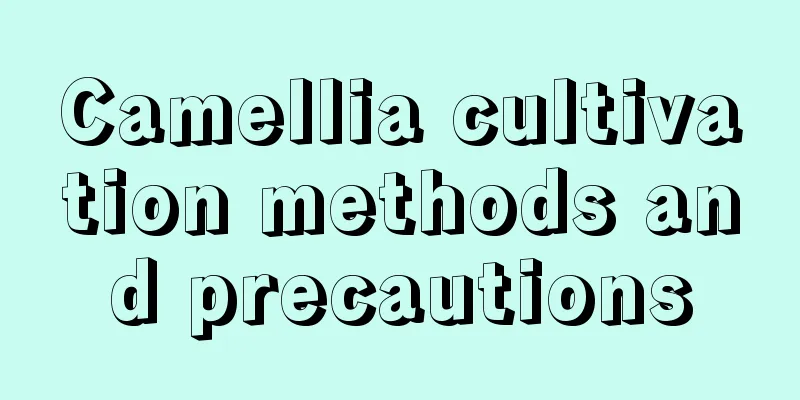Camellia cultivation methods and precautions

|
Camellia is deeply favored by flower lovers for its elegant tree shape, dark green leaves, evergreen characteristics, and bright flowers. However, if not properly maintained, camellia is prone to problems such as yellowing leaves and premature aging of flower buds. Let’s learn about the camellia cultivation methods and precautions below. 1. Pot soil selection Camellias prefer acidic, well-drained soil. It is recommended to use sandy soil, loess or humus soil, or a mixture of mountain mud, leaf mold and sand. If nutrient soil is used, it can be mixed evenly in the ratio of 1:2:1 among peat soil, leaf mold and garden soil and then planted. 2. Water properly When planting, make sure the camellia roots are in close contact with the soil. You can use a small wooden stick to gently poke around the roots to help the soil enter. The rooting water needs to be poured thoroughly and can be watered multiple times. Daily watering should be done after the surface of the potting soil is dry. Camellia is relatively drought-resistant and should not be watered excessively. 3. Fertilization during the growing season Camellia has a short vegetative growth period and spends most of its time forming buds. The vegetative growth period is from spring flowering to early summer. At this time, new shoots grow rapidly. You can apply balanced nitrogen, phosphorus and potassium fertilizers or spread controlled-release fertilizers along the edge of the pot. In summer, camellia begins to differentiate flower buds, and phosphorus and potassium fertilizers can be applied 2-3 times. It is recommended to stop fertilizing in midsummer, and apply phosphorus and potassium fertilizers again at the end of September in autumn, once every 15 days or so until flowering. 4. Lighting management Camellia likes light but cannot tolerate strong light. It can be exposed to full sunlight in spring, autumn and winter, but needs shade in summer to avoid direct sunlight to prevent sunburn on the leaves. 5. Thinning buds Camellias are often full of flower buds, but too many flower buds will lead to insufficient nutrients, and the buds will turn yellow before blooming. Bud thinning should be done when the flower buds grow to the size of soybeans, leaving 1-2 flower buds on each branch to concentrate nutrients and make the flowers large and bright. 6. Summer and winter care It is easy for camellia to survive the summer, just avoid excessive exposure to the sun. Growth is slow in summer, so it is recommended to stop applying water-soluble fertilizers . Camellia has average cold resistance, and most varieties can withstand temperatures as low as -5 degrees Celsius. It can overwinter naturally in areas south of the Yangtze River, but needs to be brought indoors in northern areas. When caring for it indoors, be sure to open the windows for ventilation at noon to prevent leaves from falling. In short, doing a good job of daily management can effectively maintain camellia, keep it growing healthily and have beautiful flowers.
|
<<: Cultivation methods and precautions of Kalanchoe
>>: What kind of soil is better for growing flowers?
Recommend
Plant these 3 kinds of vegetables at home in February. They will grow in two weeks and taste so fresh!
1. Leeks Leek should be considered one of the sim...
Can blueberries be grown in pots?
Can blueberries be grown in pots? Blueberries can...
How to trim a money tree to make it look good
When is the right time to prune a money tree? Mon...
How to take care of the succulent plants you just bought
1. Clean, trim and disinfect the roots After buyi...
The difference between purple-leaf dwarf cherry and purple-leaf plum
Different tree heights The purple-leaf dwarf cher...
What are the scented teas for OL beauty and health care?
Beauty tea Rose has the effect of nourishing the ...
What to do when camellia is frozen
1. The main symptoms of cold In winter, if we ign...
How to make roses grow more branches (how to prune to make the crown bigger)
If you want the rose to grow a crown quickly, you...
When does Kalanchoe bloom?
1. Flowering time The flowering period of Kalanch...
Diseases and Pests of Cymbidium and Their Control
Main diseases: fungal anthracnose, bacterial dise...
How to Plant Celery Seeds
Celery seed planting time Celery seeds are genera...
What fertilizer to add to the banyan tree soil
1. What fertilizer to add When changing the soil ...
What soil should be used to grow Monstera
1. High requirements for soil Monstera has relati...
The cultivation methods and precautions of Wang Lian
Temperature requirements of Victoria regia Victor...
Can Nepeta be planted in July?
Nepeta tenuifolia, also known as fragrant nepeta ...









